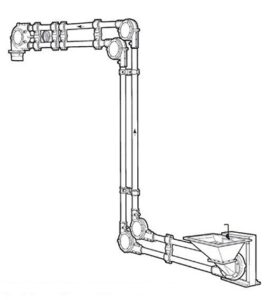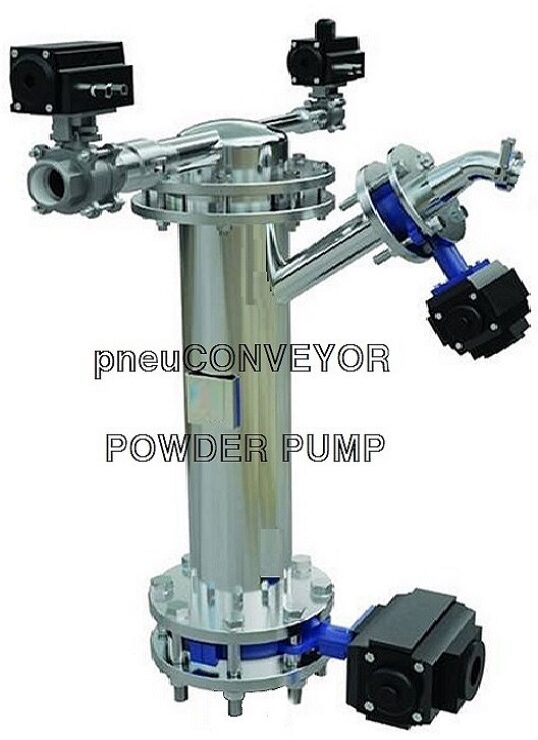HOW TUBULAR CHAIN DRAG CONVEYOR WORK ? AND HOW TO SELECT A TUBE DRAG CHAIN CONVEYOR :

pneuCONVEYOR’s – Tubular chain drag conveyor can simply handle transfer life of your bulk solids in various ways:
Tubular chain drag conveyor can convey materials at any angle and in any plane around equipment and other obstacles in your plant. The unit can be equipped with a range of specialized components to handle tough material characteristics and process requirements. The conveyor can handle friable and other delicate materials without particle degradation.
HOW TUBULAR CHAIN DRAG CONVEYOR WORK? – APPLICATION DETAILS : The tubular chain drag conveyor’s gentle handling makes it ideal for moving friable and other delicate materials without degradation and for transferring blended materials with minimal segregation. The tubular chain drag conveyors can handle highly abrasive or hot materials and safely transfer foods and other sanitary materials. The conveyors are most suitable for dusty and hazardous materials. The chain conveyor design also enables the conveyor to resist internal pressure build up caused by explosions and to contain propagating flame, making the conveyor suitable for handling potentially explosive materials.
The tubular chain drag conveyor isn’t suitable for handling a sticky powder material as well as powder containing rocks larger than 1½ inches in a vertical conveying arrangement or in a configuration with multiple turns.
SUITABILITY (INDUSTRIES) : Widely used in chemical, food, pharmaceutical, grain, mineral, plastics, agriculture, cement, mining, energy and other industries
GENERAL DESCRIPTION: The tubular chain drag conveyor (also called a tubular drag chain conveyor or tubular chain conveyor) provides gentle, enclosed continuous transfer of bulk solid materials, including fine powders, granules, pellets, and moist sludges, at any angle, in any plane, and around any obstacle.
How? The chain links in the conveyor’s chain-and[1]disc conveying mechanism function like universal joints, enabling the conveyor to simultaneously move material in multiple directions and planes. The conveyor also has a low-profile, flexible design that allows it to fit into tight spaces around existing plant equipment, the tubular drag chain conveyor can be equipped to handle highly abrasive or hot materials,
Conveyor meets sanitary requirements for transferring foods and pharmaceuticals, and safely convey potentially explosive materials—all at a much lower operating cost than that of a comparable pneumatic conveyor or any other conveying system.
The conveyor can have one or multiple material inlets and outlets. When it has one inlet, the inlet is located near the idler assembly; additional inlets can be located along the conveying line. When the conveyor has one outlet, the outlet is located at the drive assembly; additional outlets can be located along the conveying line prior to this point.
HOW THE CONVEYOR WORKS Components: The tubular drag chain conveyor consists of a tubular housing enclosing a continuous chain mounted with solid circular discs (or flights), often called a chain-and-disc assembly. The housing can include straight and curved sections constructed of carbon steel or stainless steel pipe with a typical nominal diameter of 3 to 12 inches. The housing forms conveying and return lines that can be arranged in multiple configurations, including complex loops with several turns, to suit the application layout.
A drive sprocket engages the chain-and-disc assembly at the turn at the conveying line’s end. A shaft-mounted motor, often equipped with a variable-speed drive, powers the drive sprocket; the drive sprocket and motor form the drive assembly. An idler assembly (sometimes called an idler station or tension station) is located at the end of the conveyor’s return line. The idler assembly consists of a housing enclosing an idler sprocket or other rotating mechanism and, in some cases, a chain-tensioning device.
Operation: In operation, material enters the inlet (or inlets) and, as the drive assembly pulls the chain through the housing, the material is picked up and conveyed in the spaces between the discs. The material is gently carried toward the outlet (or outlets), where it falls by gravity out of the conveyor. As the drive assembly turns, the chain moves continuously through the housing, around the drive assembly, along the return line, and through the idler assembly and any turn assemblies. The powered or idler turn assemblies assist the chain movement through the bends, which reduces frictional drag and the conveyor’s power consumption. The close clearance between the discs and pipe walls prevents material from building up inside the conveyor. Brushes or other devices can be located at the drive assembly and at various points inside the conveyor housing to clean material off the chain-and-disc assembly and prevent carryover in the return line.
Speed and capacity: When the conveyor is equipped with a variable-speed drive, the chain speed can typically be adjusted over a range from 4 to 75 fpm. This allows the conveyor to handle a range of materials at various capacities without degradation or segregation. The conveyor can also start under full load after shutdowns.
Conveyor capacity typically ranges from 80 to 1950 ft³/h, depending on the material’s bulk density and the conveyor’s pipe diameter and chain speed.
Configurations: One tubular drag chain conveyor can typically move material up to 160 feet horizontally and up to 120 feet vertically. Several conveyors can be arranged in series to provide longer horizontal and vertical conveying distances. Multiple conveyors are also commonly used to move materials from different sources, such as storage vessels, bulk bags, and manual bag dump stations, to one destination. Most tubular drag chain conveyors have modular construction with interchangeable components, allowing the conveyor to be expanded or modified to handle changing production requirements.
Power consumption: The tubular drag chain conveyor consumes relatively little electrical power because it typically uses one low horsepower motor and doesn’t require ancillary equipment such as a filter-receiver and rotary valves, as a pneumatic conveyor does.
ABOUT THE DRAG CHAIN CONVEYOR COMPONENTS
Chain: The chain can be constructed of carbon steel or stainless steel. Several chain designs are available to suit various material characteristics and operating requirements. Individual links in the chain function like universal joints, allowing the chain-and-disc assembly and the material it conveys to bend and move through multiple directions and planes.
Discs: The discs are mounted at regular intervals along the chain by various methods and can be made of ultrahigh molecular-weight, cast iron, or other polymer materials to suit the application.
Tensioner: The conveyor is equipped with a chain-tensioning mechanism to take up slack in the chain and adjust for tension changes caused by friction, flow rate changes, variations in air and material temperatures, chain and disc wear, and other factors. Keeping the proper chain tension minimizes wear to the conveyor’s chain, discs, and housing, reducing production downtime and maintenance costs.
OPTIONS AVAILABLE :
The tubular chain conveyor can be operated under pressure or vacuum. To handle a potentially explosive material, the conveyor can be purged with inert gas, such as nitrogen.
The conveying pipe can also be fitted with jacketing that circulates a heat exchanging fluid to cool hot materials during conveying.
The conveyor can be designed for frequent wash-down in clean-in-place applications, such as transferring foods and pharmaceuticals, with components such as quick-disconnect joints, FDA approved UHMW-PE discs moulded directly to a stainless steel chain, sprockets or other rotating mechanisms, and USDA accepted designs. Various clean-in-place components and drying air supply systems to minimize cleaning downtime and labour, are available from tubular drag chain conveyor manufacturers.
CONVEYOR SELECTION ADVICE: TUBULAR CHAIN DRAG CONVEYOR
To choose a tubular chain drag conveyor, take advantage of the conveyor manufacturer’s expertise in designing conveyors for a range of bulk solids applications. Provide the manufacturer with detailed information about your material, including its particle size distribution, bulk density, flowability, temperature, abrasiveness, explosibility, and other characteristics. The manufacturer will also need to know what conveying capacity you require, the available space and location of existing equipment and other fixtures in the area where the conveyor will be installed, and any special requirements the conveyor must meet, such as sanitary standards.
Finally, you’re ready to work with the manufacturer to customize a tubular drag chain conveyor for your application. This includes choosing the pipe diameter, the chain and disc assembly’s design and construction materials, the chain speed, and the conveyor configuration itself, including the number and location of powered and idler turn assemblies and inlets and outlets.
At last the result should be a suitable tubular drag chain conveyor that reliably and efficiently transfers your material for times to come.

